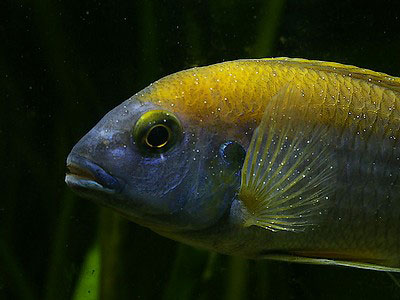
This is the most frequent freshwater fish disease. It is fully curable when will be diagnose in early stage. The protozoan, which causes this disease, has 3 life phases and it is sensitive to treatment only during one of these phases.
Phase I: The protozoa attach to the fish skin, fins or gills and they start feeding. They feed fish cells and they aren't visible yet. We can see small, white, like bubbles spots after a few days. Each spot is a single parasite. These parasites detach from the host and they fall to the bottom after maturity reached.
Phase II: The parasite form cysts. They reproduce inside these cysts by multiple transversally cell division. About 500 new parasites may develop in a single cyst within one day.
Phase III: The cysts crack after reproduction and thousands of new parasites start freely swimming and look for new hosts. Time of the maturation precisely depends on water temperature. The parasite die if it doesn't find a new host within 2-3 days. Whole cycle repeats when the parasite finds a new host. This is moment when treatment is effective.
The duration of each step strictly depends on the water temperature:
| Water temperature [°C] | Time of staying on the host [days] | Time of staying in the water [days] | Whole cycle [days] |
|---|---|---|---|
| 15 | 10-12 | 1-2 | 11-14 |
| 20 | 7 | 1 | 8 |
| 25 | 5 | 0,5 | 5,5 |
This disease is difficult to treat, because visible symptoms appear when stage of the disease is advenced and internal organs of the fish are damaged. We need transfer sick fish to a separate aquarium and we must identify main cause of the disease. We increase oxygen saturation of the water and water temperature (2-3°C), we don't use intense lighting during the treatment.
We can kill the parasites only when they are in the third life stage – when they freely swim in the water. Increasing of the water temperature (up to 28-30°C) significantly reduces the time to find a new host. But always part of the parasites reproduce inside the cysts or infect a fish in this same time. Thus whole treatment precess should last a few weeks (3-4). Then we need systematic clean bottom/substrate from the live/death cysts. We need also intensively saturate the water in oxygen and we need systematic do 50% partial water changes. We increase (and reduce) the water temperature gradually – 1°C per hour.
Not all plants and fish are resistant to increasing water temperature. This type of treatment is recommended for botias and catfish – because they are sensitive to most drugs and sea salt in the water.
This type of treatment is recommended for fish which are sensitive to high water temperature.
All drugs/preparations are effective when the parasites are in third stage of the life cycle (freely swimming). We must remove active carbon from the filter before treatment, because it reacts with medicines. We don't do partial water changes during the treatment. We need do 50% partial water change before treatment and 50% partial water change after treatment unless the manufacturer of the drug/preparation recommends otherwise. We should give the fish food enriched with vitamins and microelements during the treatment. When we use definite medicine/preparation we have to strictly follow the manufacturer's instructions. We don't increase doses, we don't shorten recovery time.
The most popular drugs/preparations: